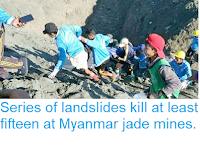At least thirteen people died in a series of landslides around the mining town of Hpakant in Kachin State, Myanmar, on Friday 22 June 2018. Four people are known to have died in a landslip on a spoil heap in the Sithu Mining Block, and it is feared that others may be unaccounted for in this incident (spoil-heap workers, known as Yay Ma Say, are often reluctant to discuss
their activities with outsiders, even rescue workers, due to the
legally dubious nature of the work), while seven are known to have died in a similar incident at Seikmu, while two women died in a flash flood the town of Hpakant itself.
Houses undermined by a flash flood in Hpakant, Myanmar, on 23 June 2018. Myanmar International Television.
Myanmar is the world's largest producer of jade, though much of this is
produced (along with other precious and semi-precious minerals such as
amber) at unregulated (and often illegal) artisanal mines in the north
of the country, from where it is smuggled into neighbouring China.
Accidents at such mines are extremely common, due to the more-or-less
total absence of any safety precautions at the site. At many sites this
is made worse by the unregulated use of explosives to break up rocks,
often leading to the weakening of rock faces, which can then collapse
without warning. The majority of people in this industry are migrant
workers from the
surrounding countryside, not registered with any local authority, which
can make it difficult for rescuers to identify victims following such
events, or even gain accurate assessments of the number of people likely
to have been involved in such accidents.
The incidents occurred following several hours of rain in the area associated with the Southeast Asian Southwest Monsoon, which has also caused a series of landslips and flash floods in the area. Landslides are a common problem after severe weather events, as excess
pore water pressure can overcome cohesion in soil and sediments,
allowing them to flow like liquids. Approximately 90% of all landslides
are caused by heavy rainfall. This year's monsoon has been particularly severe, with floods and landslips occurring across Myanmar.
The approximate location of the town of Hpakant. Google Maps.
Monsoons
are tropical sea breezes triggered by heating of the land during the
warmer part of the year (summer). Both the land and sea are warmed by
the Sun, but the land has a lower ability to absorb heat, radiating it
back so that the air above landmasses becomes significantly warmer than
that over the sea, causing the air above the land to rise and drawing in
water from over the sea; since this has also been warmed it carries a
high evaporated water content, and brings with it heavy rainfall. In the
tropical dry season the situation is reversed, as the air over the land
cools more rapidly with the seasons, leading to warmer air over the
sea, and thus breezes moving from the shore to the sea (where air is
rising more rapidly) and a drying of the climate.
Diagrammatic representation of wind and rainfall patterns in a tropical monsoon climate. Geosciences/University of Arizona.
Much of Southeast Asia has two distinct Monsoon Seasons, with a Northeast Monsoon driven
by winds from the South China Sea that lasts from November to February
and a Southwest Monsoon driven by winds from the southern Indian Ocean from March to October. Such a double Monsoon Season is common
close
to the equator, where the Sun is highest overhead around the equinoxes
and lowest on the horizons around the solstices, making the solstices
the coolest part of the year and the equinoxes the hottest. However
Myanmar is largely protected from the Northeast Monsoon by the mountains
separating the country from Yunnan Province in China.
The winds that drive the Northeast and Southwest Monsoons in Southeast Asia. Mynewshub.
See also...
Follow Sciency Thoughts on Facebook.










